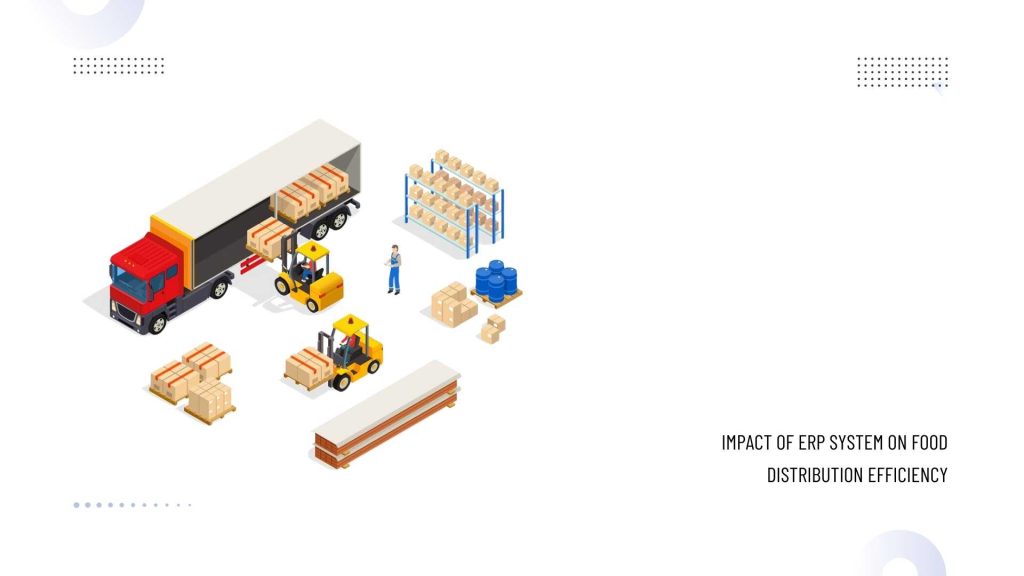In today’s complex supply chains and high demand for food products, the role of the food distribution industry is crucial in ensuring efficient and safe delivery from producers to consumers. Maintaining high levels of efficiency is now more critical than ever. ERP has emerged as a powerful tool that significantly enhances the efficiency of food distribution operations. We will explore various ways ERP impacts food industry distribution efficiency and the challenges associated with its implementation.
Impact of ERP on Food Distribution
Supply Chain Visibility & Coordination
ERP systems provide comprehensive visibility into the supply chain, enabling food distributors to track and manage inventory in real-time. This enhanced visibility facilitates better stakeholder coordination from suppliers to end consumers.
By integrating data from various sources, ERPs help monitor the movement of goods, predict potential disruptions, and make informed decisions to maintain a seamless supply chain. This level of transparency ensures that products are available when and where needed, reducing the risk of stock outs and overstock situations.
Efficient Order Management
Managing orders is crucial in the food distribution industry, where timeliness and accuracy are paramount. ERP systems streamline order management by automating order entry, invoicing, and shipping processes.
Customers receive their orders promptly due to the automation that reduces errors and speeds up order processing. Additionally, ERP systems can handle large orders, making it easier for distributors to scale their operations without compromising service quality.
Food Safety and Traceability
Traceability and Food safety are critical concerns in the food distribution industry. ERP systems enhance food safety by providing robust traceability features that track products from the point of origin to the final consumer.
This traceability is essential for meeting regulatory requirements and ensuring swift responses to food safety issues, such as recalls. With detailed records of every step in the supply chain, distributors can quickly identify and isolate contaminated products, thereby protecting consumer health and maintaining trust.
Cost Optimization
ERP systems contribute to cost optimization by improving operational efficiency and reducing waste. By providing accurate inventory data and demand forecasts, ERPs help distributors minimize excess inventory and reduce storage costs.
Additionally, the automation of various functions lowers labor costs and minimizes human errors. Overall, ERP systems enable food distributors to operate more cost-effectively, which can translate into competitive pricing and better margins.
Demand Forecasting
Precise demand forecasting is essential for retaining optimal inventory levels and meeting customer demand. ERP systems leverage historical data and advanced analytics to generate reliable demand forecasts.
These forecasts enable food distributors to plan their procurement and production activities more effectively, ensuring they have the right products in the right quantities at the right time. By aligning supply with demand, distributors can reduce waste, avoid stock outs, and enhance customer satisfaction.
Challenges
Initial Costs & Resource Allocation
Implementing an ERP solution can be an effective investment, involving substantial initial costs for software and consulting services. Additionally, organizations must allocate resources for the implementation process, which can divert attention from day-to-day operations. Thorough budgeting is essential to managing these costs effectively and ensuring a smooth implementation.
Data Integration and Migration
Integrating and migrating data from existing systems to a new ERP platform can be complex and time-consuming. Ensuring data accuracy and consistency is crucial to avoid disruptions in operations. Organizations must develop a clear data migration strategy and invest in tools and expertise to facilitate seamless data integration.
Organizational Change and Training
Adopting an ERP solution requires significant organizational change, including new workflows and processes. Employees may need training to adapt to the new system and leverage its full capabilities. Effective change management and extensive training programs are required to ensure a successful transition and maximize its benefits.
Scalability and Customization
As food distribution businesses grow and evolve, their ERP systems must be scalable and customizable to meet changing needs. Selecting an ERP solution that can adapt to future requirements is critical for long-term success. Organizations should evaluate potential ERP systems’ scalability and customization options to ensure they can support growth and innovation.
Conclusion
Acumatica Cloud ERP is a powerful solution that boosts food distribution efficiency through features designed to enhance decision-making, reduce waste, and ensure compliance with industry regulations.
Acumatica Cloud ERP assists food distributors in optimizing operations, reducing costs, and delivering high-quality products to consumers. With its scalability and flexibility, Acumatica Cloud ERP is well-equipped to meet the needs of the food distribution industry, supporting sustainable growth and success.

Vijay comes with a vast experience in ERP and enterprise solutions space with about 20 years of experience in various packaged application like Acumatica, SAP, Orion, Salesforce.com, SugarCRM and, SalesLogix.

